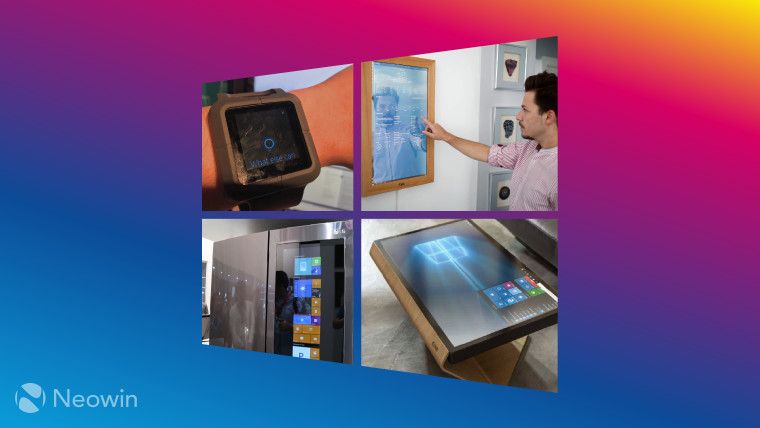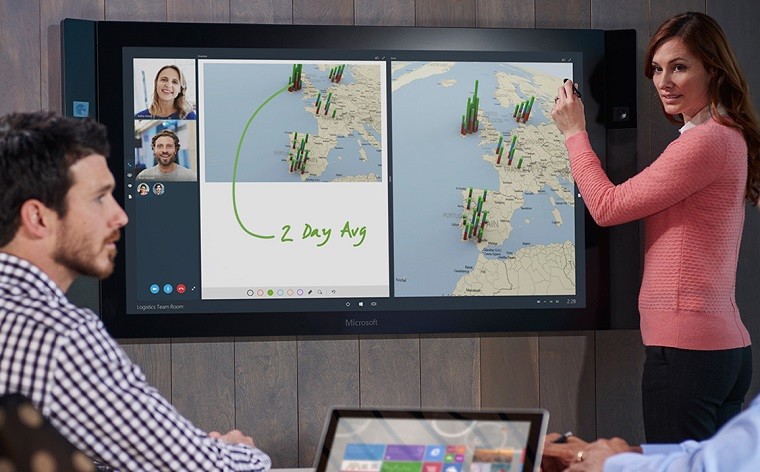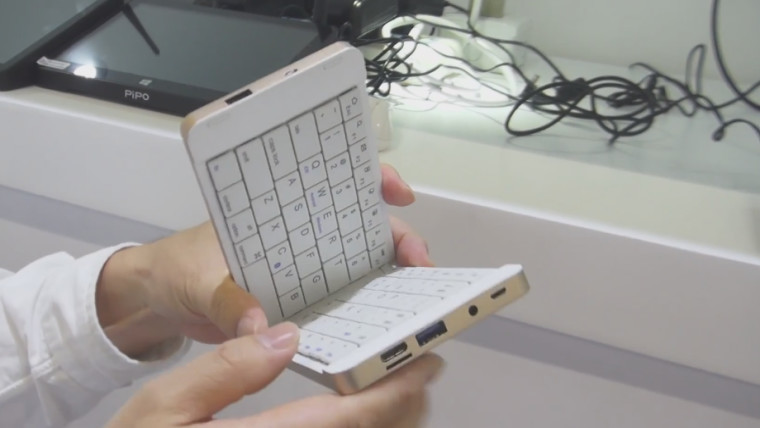
Just over two years ago, following months of testing with the help of its global community, Microsoft launched Windows 10. Since then, the number of Windows Insiders has grown to over ten million, and Windows 10 itself is in use on more than 500 million monthly active devices.
The diversity of the Windows hardware ecosystem has grown too in the Windows 10 era. With Windows 8 and 8.1, Microsoft laid the groundwork for a greater number of device types running the OS than ever before. But Microsoft developed that vision further with its work on OneCore, the modular foundation on which each modern Windows edition is now built to suit the distinct requirements of a vast range of hardware.
The flexibility of OneCore has made it possible for Microsoft and its partners to bring Windows 10, and its various offshoots, to many types of hardware - from tiny, low-power computers, to far mightier machines.

Desktop PCs
The desktop PC is perhaps the quintessential idea of a Windows machine; indeed, for many of us, it was the first computer we ever owned. But desktops have come a long way since the big, bland, beige boxes of yesteryear.
In recent years, manufacturers have become far more creative with their designs, unleashing a dizzying array of form factors, such as HP's stylish Pavilion Wave 'speaker PC', and Acer's modular Revo Build. Some of these have been more successful than others, but buying an off-the-shelf Windows 10 desktop no longer means surrendering to boring design.

All-in-ones
Microsoft was a bit late to its own party when it launched the Surface Studio, a 28-inch all-in-one touchscreen PC, aimed at creative professionals - but it certainly arrived in style. The compact all-in-one form factor is desirable for many buyers, but not everyone can afford the Surface Studio, which is priced at up to $4,199.
Manufacturers have been offering all-in-ones for many years, and now cater for all sorts of budgets and requirements with their Windows 10 machines. Dell's Inspiron 27, for example, is VR-ready, and has a 4K display, along with other high-end features. Acer's sleek Aspire C features slim bezels and a decent set of specs, priced from $449. Samsung's All-in-One has 7th-gen Intel Core processors, and an integrated 'sound bar'. There's virtually no end of options to choose from.

Gaming desktops
Since launching Windows 10 in 2015, Microsoft has made considerable improvements to the OS to make it more appealing to gamers. Along with various other measures, it introduced support for cross-platform play, as well as a performance-enhancing Game Mode in the Windows 10 Creators Update. Those efforts have been paying off; for example, on Steam, more than half of gamers now use Windows 10.
Manufacturers seem to be pleased with Microsoft's gaming efforts in Windows 10 too. Alienware co-founder Frank Azor praised the OS for being "more gamer-focused" than Windows 8, and this kind of support has given rise to some exciting new gaming machines from many OEMs.
HP's monstrous OMEN X Desktop is one example of the new generation of PCs aimed directly at gamers, and of course, Alienware continues to launch new Windows 10 machines, the latest in its long and distinguished line of gaming PCs. There are even options available for budget-conscious gamers, such as Dell's Inspiron Gaming Desktop.

Gaming laptops
There's no shortage of gaming laptops running Windows 10 these days too, and their designs and specs are becoming increasingly extreme. Marvel at the glorious madness of Razer's Project Valerie, which has three (!!) built-in 4K displays (although, sadly, that device remains a concept, for now).
Back in the real world, hardcore gamers with deep pockets can purchase Acer's only-slightly-less-bonkers Predator 21 X, a gaming notebook with a 21-inch curved display and dual Nvidia GTX 1080 graphics cards, priced from $8,999. Lenovo's more affordable Legion Y720 and Legion Y920, and the slim ASUS ROG Zephyrus, are among the huge - and growing - selection of Windows 10 notebooks coming to market with gamers in mind.

Good ol' fashioned laptops
There's still a large market for 'conventional' notebooks with desirable specs. Indeed, such is the demand for such devices that Microsoft recently launched its new Surface Laptop, for buyers who favor stylish design over the high-end bells and whistles of hardcore gaming machines and mobile workstations.
Like the Surface Laptop, many such notebooks from other manufacturers include touchscreen support, taking advantage of the touch-friendly features in Windows 10.

Ultra-low-cost laptops
You don't need to spend a fortune these days to get a decent PC with solid specs, for web browsing, creating and editing documents, and other day-to-day tasks. In fact, you can get a pretty good 15-inch laptop for around $300, with Intel's latest 7th-gen processors, and 1TB of storage.
But even more affordable options are available for those with the most modest budgets. In 2015, for example, Acer launched the Windows 10 Cloudbook for just $169, and Dell's Inspiron 11 3000 series remains available for as little as $173.
Microsoft's partners are also launching more low-cost PCs targeting the education sector, running its new Windows 10 S edition, which is restricted to running apps downloaded from the Windows Store. The first of these are now available from $249, but more are on the way for as little as $189.

Convertibles and 2-in-1s
These devices have exploded in popularity over the last few years, with sales growing even as the wider PC market has struggled. Lenovo, HP, Acer, Dell, and many others continue to launch such devices, most of which have a 'traditional' laptop form factor, but with special hinges that allow them to be used in a variety of ways.
Some less conventional variations on the theme have popped up too, such as Acer's distinctive Aspire R 13. Lenovo's unusual Yoga Book - which is also available in Android flavor - is another example of how manufacturers are pushing the boundaries with hardware design in the Windows 10 era.
Microsoft has also launched its own distinctive take on the convertible theme with its Surface Book, a high-end notebook with a detachable display. Some models also feature a discrete GPU, offering improved graphics performance, and the latest 'Performance Base' models feature are even more powerful. Inspired by the Microsoft device, Porsche Design introduced a similar device, the Book One, although it does differ from the Surface Book in some key areas.

Tablets
Windows 10 has a touch-friendly 'tablet mode' that adapts the interface for tapping and swiping with fingers. Even more than Windows 8.1, this has made the OS a much more attractive proposition for tablets (or when using a 2-in-1 as an oversized tablet).
There's a huge variety of Windows 10 tablets available to suit a range of budgets, and many of them are offered with detachable keyboards, some of which must be purchased separately. The ASUS Transformer Mini is an excellent example; currently on sale for just $249, it comes with a keyboard and a stylus included in the price, and even has a fingerprint scanner that supports Windows Hello biometric authentication.
For those with bigger budgets, Microsoft's new Surface Pro shows that a tablet can offer plenty of power in a compact package. Priced at up to $2,699, it's available with Intel's newest 7th-gen processors, up to 16GB RAM, and 1TB of storage. Microsoft absurdly promotes the Surface Pro as a "laptop" - but it's clearly a tablet (you even have to buy the keyboard separately).
There are plenty more Windows 10 tablets out there aside from these examples, of course.

Handheld PCs
There are some even more unusual Windows 10 devices out there too, including a new wave of handheld PCs with ultra-compact designs. GPD is leading the charge with such devices, including the WIN, a handheld with its roots in portable gaming, which we reviewed earlier this year.
Last month, GPD also launched the Pocket, a tiny PC with a 7-inch Full HD display, 8GB of RAM and 128GB of storage, which is currently available for under $500.

Phones
Microsoft has had a troubled history in the smartphone space, and things haven't improved since it launched Windows 10 Mobile at the end of 2015. While it succeeded in attracting some brands to offer phones with its latest mobile OS, most have now abandoned the platform, and even Microsoft itself no longer builds Windows phones.
HP's Elite x3 remains available, and Alcatel recently (re)launched its Windows 10 Mobile flagship in Europe. Both of these devices support the operating system's PC-like Continuum feature, which allows owners to use a mouse and keyboard with the device when it's connected to a larger display - a feature that Samsung recently copied with its new Galaxy S8 flagships.

Surface Hub
Microsoft's Surface Hub is a giant touchscreen PC designed to improve collaboration and productivity in workplace and education environments. It runs a specialized version of Microsoft's OS called Windows 10 Team, and is available in 55- and 84-inch versions, priced at $8,999 and $21,999, respectively.

HoloLens
Described by Microsoft as "the first self-contained, holographic computer", HoloLens went on sale last year as a Development Edition device, and is now available in several markets around the world. Like the Surface Hub, HoloLens runs a specialized version of Windows 10, originally called Windows Holographic, but now known as Windows Mixed Reality.
A new version of HoloLens is in development, but it's not expected to arrive for a while.

Windows Mixed Reality headsets
In addition to HoloLens, Windows Mixed Reality is also available on new virtual reality headsets, which operate while tethered to Windows 10 PCs.
You can read more about what it's like to use one of these headsets in our hands-on feature.

Xbox One consoles
At the end of 2015, Microsoft brought Windows 10 to its Xbox One console. With it, came support for the Universal Windows Platform, making it much easier for developers to create apps for other Windows 10 devices as well as for the Xbox One, and for the Xbox One S, which launched last year.
Microsoft has already released the first preview of its next major Windows 10 update for the Xbox One family.

Smart TVs
Windows 10 can be found on many more devices, including some you might not expect. For example, in late 2015, Videocon unveiled the world's first Windows 10-powered smart TV in partnership with Microsoft, with a 32- or 40-inch display, 2GB RAM and 16GB of storage.

Set-top boxes
In 2015, Chinese manufacturer PiPO unveiled the X8, a 'Windows TV box and desktop tablet', priced under $100, and running Windows 8.1. It seems that that device was a success, as it launched the X9 with Windows 10 a few months later - check out our review here.

Smart mirror
You can even get a Windows 10 mirror (!!). Earlier this year, a German manufacturer launched the $2,000 Dirror - a portmanteau of 'digital mirror' - enabling owners to stay productive while indulging in their narcissism.

Refrigerators
What smart home would be complete without a smart refrigerator? Last year, LG launched the Smart Instaview Refrigerator, which has a 29-inch translucent touchscreen - so you can see what's inside your fridge without the enormous effort of actually opening the door - and runs Windows 10, with Cortana voice support.

Windows 10 brings the heat
This stylish thermostat, featuring a translucent touchscreen, is the result of a Microsoft collaboration with Johnson Controls. Running Windows 10 IoT Core, and with Cortana voice support, it may well be the first of many such devices that buyers will welcome into their homes.

Yes, it's a $5,500 Windows 10 coffee table
Your eyes are not deceiving you. Perhaps inspired by Microsoft's "big-ass table", French company Kineti launched a Windows 10 coffee table with a 42-inch touchscreen protected by 'unbreakable' glass. The $5,500 table has a full PC built into it, featuring an Intel Core i5 processor, 8GB of RAM, and a 120GB SSD.

Restaurant tables
At Microsoft's Build 2017 developer conference in May, Kodisoft showcased its IRT Table, an interactive touchscreen table designed for restaurants. Priced at $15,000, it has a 4K display, Nvidia GeForce GTX 1070 GPU, and Intel Core i7 processor, and runs Windows 10 IoT Core.
The touchscreen can be used for playing games, ordering food, or even for buying drinks for people at other tables. Check out our hands-on video to find out more.

Wearables
Microsoft announced a new Windows 10 wearable device in April, developed by TrekStor for commercial customers. The 'B2B commercial-grade wearable' runs Windows 10 IoT Core, but won't be made available to consumers - and with looks that only a mother could love, perhaps that's for the best. Check out more info on the device in our hands-on gallery.
Microsoft abandoned its efforts to bring Windows 10 to its own Band wearable devices last year, and later discontinued that product line.

Internet of Things devices
Windows 10 IoT Core is an ultra-lean version of the OS designed primarily for small, low-power Internet of Things devices - but as we've seen with the IRT Table and TrekStor wearable, it can be used in many other scenarios. It can even be found on specialized industrial devices, like the rugged Panasonic Toughpad FZ-F1 handheld, as well as on tiny computing devices like the hugely popular Raspberry Pi range.

Keyboard PCs
Believe it or not, the foldable keyboard you see above is actually a Windows 10 PC, with an Intel Atom processor, up to 4GB RAM, and 64GB of storage. Built by PiPO (makers of the set-top box mentioned earlier), it even features a range of ports - and if you prefer, an alternative, non-foldable model is available with a built-in trackpad.

PC sticks
Perhaps it's not so unbelievable that PiPO squeezed a Windows 10 PC into a keyboard when manufacturers have been building PCs crammed into small dongle-sized devices for some time. Intel's Compute Sticks are among the options available, and even feature powerful Core processors.
More affordable and less powerful models have been offered by other manufacturers too, such as the $129 ASUS VivoStick.

Retail devices
Windows 10 can be found on a huge number of specialized commercial devices too, including point-of-sale PCs, like HP's new ElitePOS.
The operating system's flexibility, along with Microsoft's capable corporate device management tools, are making it an increasingly popular choice for business usage, not just in offices, or even at checkouts, but also in other line-of-business scenarios, such as information points, self-service check-in terminals, and digital signage.

What's next?
There's no doubt plenty more devices that have been overlooked in this list. But while there may be some omissions, it shows that there appear to be few limits to Windows 10's potential in the hardware space.
Manufacturers are already looking ahead, imagining what Windows devices of the future might look like. Just a few weeks ago, for example, Lenovo showed off this mouth-watering concept for a notebook with a flexible display that curves into its base.
Meanwhile, a patent awarded to Microsoft in January for foldable devices prompted months of speculation that the company will release its much-rumored 'Surface Phone' with such a form factor. While that might be optimistic, it's hard not to get excited by beautiful concept renders for such a device, like these.
For now, we'll have to wait and see what the future holds for Windows 10 - but with such a diverse range of hardware already available, the present is pretty good too.
















27 Comments - Add comment